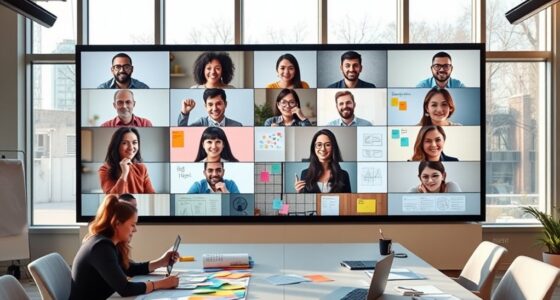Pairing designers and developers in collaborative duos can profoundly accelerate your team’s learning, improve project quality, and spark innovation. This approach fosters real-time communication, quick problem-solving, and shared understanding of goals, leading to more cohesive and efficient workflows. By combining diverse perspectives, you break silos and create a culture of continuous improvement. If you keep exploring, you’ll discover practical strategies and tools that make these partnerships even more effective.
Key Takeaways
- Cross-functional pairing fosters rapid knowledge transfer and skill sharing between designers and developers.
- Collaborative duos enhance project quality and innovation through real-time feedback and shared perspectives.
- Pairing accelerates decision-making by clarifying technical feasibility and design intent simultaneously.
- Regular communication and visual tools improve understanding, reducing misunderstandings and rework.
- Building mutual trust and empathy creates a cohesive environment that supports continuous learning and improvement.
The Benefits of Pairing Designers and Developers

Pairing designers and developers can markedly boost the quality and efficiency of your projects. When you foster design synergy, you create a collaborative environment where ideas flow freely, and solutions become more refined. This close partnership sparks innovation, as both parties bring unique perspectives that challenge assumptions and inspire creative problem-solving. You’ll find that shared knowledge accelerates decision-making, reducing misunderstandings and rework. By working side by side, you gain real-time feedback, ensuring the design aligns with technical feasibility and vice versa. This seamless interaction not only enhances the final product but also builds mutual understanding and trust. Additionally, understanding the importance of cross-functional pairing can lead to more cohesive and adaptable project outcomes. Overall, pairing designers and developers transforms your workflow into a more dynamic, innovative process that delivers better results faster.
Building Effective Collaboration Frameworks

To maximize the benefits of pairing designers and developers, you need a solid framework that fosters effective collaboration. Start by establishing cultural alignment, ensuring both roles value openness, mutual respect, and shared goals. This creates a foundation where team members feel comfortable sharing ideas and feedback. Emphasize role flexibility, encouraging individuals to step beyond strict boundaries and contribute in diverse ways. This adaptability promotes learning and innovation, breaking down silos. Clearly define responsibilities but remain open to adjustments as projects evolve. Use shared tools and processes that support transparency and collective ownership. Incorporating primitive survival techniques into team training can also foster resilience and adaptability, which are valuable in dynamic project environments. By cultivating cultural alignment and role flexibility, you’ll create a dynamic environment where cross-functional pairs thrive, accelerate learning, and deliver better outcomes.
Enhancing Communication and Understanding

Effective communication starts with bridging language gaps and clarifying design intent so everyone’s on the same page. You can foster mutual empathy by actively listening and understanding different perspectives. When you focus on these points, collaboration becomes smoother and more productive. Incorporating interior design principles can further enhance understanding and create more cohesive teamwork.
Bridging Language Gaps
Have you ever struggled to communicate across different languages or cultural backgrounds? Bridging language gaps is essential in cross-functional pairing, especially when team members come from diverse cultural nuances. Language barriers can lead to misunderstandings, misinterpretations, and delays. To overcome this, focus on clear, simple communication, avoiding jargon that might be confusing. Use visual aids, sketches, or prototypes to illustrate ideas when words aren’t enough. Encourage open dialogue and ask questions to ensure everyone’s on the same page. Recognize that cultural nuances influence how messages are received and interpreted. By actively listening and adapting your communication style, you foster better understanding, build trust, and accelerate collaboration. Overcoming language barriers isn’t just about words — it’s about connecting across differences to achieve shared goals. Additionally, understanding the role of color accuracy in conveying information effectively can enhance visual clarity and comprehension during collaborative efforts.
Clarifying Design Intent
Clarifying design intent is essential for ensuring everyone understands the purpose behind your ideas. When you communicate clearly, you help your team maintain visual consistency, making the product more intuitive. Use visuals like sketches, wireframes, and annotations to convey your concepts precisely. Incorporate user feedback to validate assumptions and identify areas needing clarification. When team members understand the intent, they can align their work more effectively, reducing misunderstandings and rework. Be explicit about design goals and the reasoning behind choices. Encourage open dialogue, so questions surface early. This clarity accelerates decision-making and fosters a shared vision, ensuring the final product resonates with users and meets project objectives. Additionally, understanding the Bedroom space can inspire better design communication by emphasizing comfort and aesthetic coherence.
Building Mutual Empathy
Building mutual empathy is essential for improving communication and understanding within a team. Developing emotional intelligence allows you to recognize and manage your own feelings while tuning into your partner’s emotions. This awareness creates a safe space for open dialogue and trust. Cultural awareness plays a pivotal role by helping you appreciate diverse perspectives, reducing misunderstandings rooted in differences. To foster empathy, actively listen without judgment, ask clarifying questions, and acknowledge your partner’s viewpoints. Show genuine curiosity about their experiences and challenges. By prioritizing emotional intelligence and cultural awareness, you build a foundation of trust and respect. This mutual understanding accelerates collaboration, making problem-solving more intuitive and efficient. Incorporating empathy-building techniques can further strengthen your team dynamics. Ultimately, empathy bridges gaps, fostering stronger, more cohesive cross-functional partnerships.
Streamlining Workflow Through Real-Time Feedback

Real-time feedback allows you to address issues immediately, boosting overall efficiency. When problems are resolved quickly, team members gain clearer understanding and stay aligned. Continuous adjustments keep workflows smooth, saving time and reducing errors. Incorporating sound vibrations into feedback sessions can further enhance focus and receptivity.
Instant Collaboration Enhances Efficiency
Instant collaboration accelerates workflows by enabling team members to share feedback and resolve issues immediately. This real-time interaction fosters creative synergy, allowing designers and developers to build on each other’s ideas instantly. As you exchange skills, you reduce delays caused by waiting for feedback or approvals, keeping projects moving smoothly. When feedback is instant, misunderstandings clear up quickly, and adjustments happen on the spot, saving time and preventing rework. This seamless skill exchange boosts overall efficiency, as both of you stay aligned on goals and challenges. By working together in real-time, you create a dynamic environment where innovative solutions emerge faster, and progress accelerates. Instant collaboration becomes an essential tool for maximizing productivity and maintaining momentum throughout your project.
Rapid Issue Resolution Promotes Clarity
When issues arise during a project, addressing them quickly prevents confusion and keeps everyone on the same page. Rapid issue resolution is essential for maintaining clarity and momentum. You need to use conflict resolution skills to uncover the root of the problem without escalating tensions. Analytical thinking helps you assess the situation objectively, identify solutions swiftly, and communicate clearly with your partner. By tackling issues in real-time, you minimize misunderstandings and prevent small problems from escalating into larger roadblocks. This proactive approach encourages transparency, fosters trust, and streamlines workflow. When you resolve issues promptly, you ensure the team remains focused, aligned, and equipped to move forward efficiently, accelerating learning and project progress. Incorporating effective communication techniques can further enhance your ability to resolve issues swiftly and maintain a harmonious collaboration.
Continuous Adjustment Streamlines Tasks
As you receive ongoing feedback during a project, you can make immediate adjustments that keep tasks aligned with goals. This approach fosters adaptive workflows, allowing you to respond quickly to challenges or new insights. By embracing iterative improvements, you refine processes in real time, reducing wasted effort and preventing misalignment. Continuous adjustment encourages you to stay flexible, ensuring that each step builds toward the desired outcome. It also helps identify issues early, so you can course-correct promptly. This dynamic way of working boosts efficiency, accelerates learning, and enhances collaboration between designers and developers. Ultimately, real-time feedback streamlines your tasks, making your workflow more responsive, productive, and aligned with project objectives.
Fostering Creativity and Innovation

Cross-functional pairing unblocks new avenues for creativity and innovation by bringing together diverse perspectives and expertise. When designers and developers collaborate closely, they create a fertile environment for creative synergy. This blending of skills sparks fresh ideas and pushes boundaries beyond conventional thinking. You’ll find that innovative brainstorming flows more freely, as each person offers unique insights that challenge assumptions and inspire solutions. By working side by side, you eliminate silos, making it easier to experiment and iterate quickly. This dynamic fosters an atmosphere where creativity can thrive, leading to innovative approaches that may not emerge in isolated teams. Additionally, understanding interior design basics helps team members communicate more effectively about functionality and aesthetics, further enhancing collaborative innovation. Ultimately, this partnership accelerates idea generation, helping you develop more inventive, user-centered products with greater efficiency.
Overcoming Common Challenges in Cross-Functional Teams

Collaborating across diverse teams often introduces challenges such as miscommunication, conflicting priorities, and differing workflows. To overcome these issues, focus on conflict resolution early and openly. Address misunderstandings directly and encourage honest dialogue, ensuring everyone feels heard. Role clarification is equally essential; clearly define each team member’s responsibilities to prevent overlaps and confusion. When roles are ambiguous, tension can rise, hindering progress. Regular check-ins help maintain alignment and clarify expectations. Emphasize active listening, patience, and transparency to build trust and streamline collaboration. By proactively managing conflicts and establishing clear roles, you create a more cohesive environment. Recognizing the importance of team dynamics can further enhance cooperation and productivity. This approach reduces friction, accelerates decision-making, and keeps your cross-functional team moving forward effectively.
Practical Strategies for Successful Duos

To make your pair work effectively, establish clear communication channels so both of you stay aligned. Set shared learning goals to guarantee you’re growing together and tackling challenges as a team. Additionally, schedule regular collaborative sessions to keep momentum and address issues before they escalate.
Clear Communication Channels
Effective communication is the foundation of any successful pairing, and establishing clear channels guarantees everyone stays on the same page. Prioritize communication clarity by using straightforward language and confirming understanding regularly. This reduces misunderstandings and ensures both of you are aligned on project goals. Set up consistent feedback loops, such as daily check-ins or instant messaging, to address questions promptly and keep momentum. Encourage open dialogue, where both of you feel comfortable sharing ideas and concerns without hesitation. Clear channels help streamline decision-making and foster trust. Remember, when communication flows smoothly, you can quickly adapt, troubleshoot, and learn from each other, accelerating progress and strengthening your collaboration.
Shared Learning Goals
Building shared learning goals helps you and your partner stay aligned on growth and development. When you establish clear objectives, you create a foundation for shared learning that benefits both of you. These goals ensure you’re working toward common outcomes, fostering goal alignment that accelerates progress. By defining what skills or knowledge each person wants to gain, you encourage accountability and focus. Regularly revisit these goals to track progress and adjust as needed, guaranteeing continuous improvement. Shared learning isn’t just about individual growth; it’s about strengthening your partnership through mutual understanding. Clear, aligned goals help you stay motivated and engaged, making your collaboration more effective. Ultimately, shared learning goals create a cohesive path that pushes both of you forward.
Regular Collaborative Sessions
How can you keep your partnership energized and focused? Regular collaborative sessions are key. Establish pairing rituals, like daily check-ins or weekly review meetings, to create consistency and build momentum. These rituals reinforce your commitment and provide dedicated time for shared problem-solving. During these sessions, prioritize open feedback loops—encouraging honest, constructive communication helps identify challenges early and fosters continuous improvement. Make sure to set clear agendas and goals to keep discussions productive. By maintaining a steady rhythm of collaboration, you prevent silos and ensure both of you stay aligned. Over time, these consistent efforts deepen your understanding of each other’s strengths, streamline workflows, and accelerate learning, making your duo more effective and resilient.
Tools and Technologies Supporting Pairing Efforts

Tools and technologies play a essential role in facilitating smooth and efficient pairing efforts across teams. Version control systems, like Git, enable both designers and developers to collaborate on code seamlessly, track changes, and resolve conflicts quickly. Prototyping tools, such as Figma or Adobe XD, allow designers to create interactive mockups that developers can reference directly, fostering faster iteration and shared understanding. These tools help bridge gaps in knowledge and streamline communication, ensuring everyone stays aligned. Real-time collaboration platforms like Slack or Microsoft Teams also support instant messaging and video calls, making it easier to discuss ideas on the fly. By leveraging these technologies, you create an environment where cross-functional pairing feels natural, productive, and continuously improving.
Measuring Success and Growth in Pairing Initiatives

To effectively measure success and growth in pairing initiatives, you need clear metrics that reflect collaboration quality and outcomes. Success metrics could include the speed of project milestones, quality improvements, or user satisfaction scores. Establishing feedback loops is essential; they enable you to gather insights from both designers and developers regularly, allowing you to adjust approaches and foster continuous improvement. Track how well teams communicate, how quickly issues are resolved, and how effectively knowledge transfer occurs. By combining quantitative data with qualitative feedback, you gain a thorough view of pairing success. Regular evaluations ensure you’re not only measuring results but also nurturing a collaborative environment that encourages ongoing learning and development.
Case Studies of Successful Designer-Developer Partnerships

Real-world examples demonstrate that successful designer-developer partnerships can substantially boost project outcomes and team morale. In one case, a team integrated UX research early, involving stakeholders directly in the process. This collaboration allowed both designers and developers to understand user needs deeply, leading to more intuitive solutions. By sharing insights and iterating together, they reduced miscommunication and accelerated development cycles. Another example highlights how cross-functional pairing improved stakeholder engagement, ensuring that feedback shaped the product at every stage. This continuous dialogue fostered trust and ownership among stakeholders, resulting in a more aligned product vision. These case studies show that combining UX research with close designer-developer collaboration creates a stronger, more responsive workflow that benefits the entire project.
Frequently Asked Questions
How Do Pairings Adapt to Remote or Hybrid Work Environments?
In remote or hybrid work environments, you adapt pairings by embracing virtual collaboration tools like video calls and shared documents. You foster effective communication through regular check-ins and clear goals. Asynchronous feedback becomes essential, allowing you and your partner to review work at different times and provide input without disrupting flow. This flexibility helps maintain momentum, strengthens your partnership, and accelerates learning despite physical distance.
What Skills Are Essential for Successful Designer-Developer Duos?
To succeed as a designer-developer duo, you need strong collaborative communication and mutual empathy. You should actively listen, share ideas openly, and respect each other’s expertise. Flexibility and a willingness to learn from one another foster trust. Being proactive in addressing challenges and maintaining transparency helps build a cohesive partnership. These skills create a seamless workflow, accelerate learning, and guarantee both of you work effectively towards shared goals.
How Can Teams Resolve Conflicts During Collaborative Sessions?
When conflicts erupt like volcanoes during collaboration, you can tame them with powerful conflict resolution tactics and clear communication strategies. You’re the hero who keeps conversations constructive, listens actively, and clarifies misunderstandings fast. By fostering openness and mutual respect, you turn fiery disagreements into opportunities for growth. Remember, smooth conflict resolution isn’t magic — it’s your skillful use of communication strategies that transforms chaos into collaboration and keeps your team flying high.
What Are Common Pitfalls in Cross-Functional Pairing Initiatives?
In cross-functional pairing initiatives, common pitfalls include misaligned expectations, which can lead to misunderstandings about roles and goals. You might also face uneven participation, where one team member dominates while the other holds back. To avoid these issues, set clear objectives upfront, encourage open communication, and foster an environment where both partners actively contribute. This helps guarantee a balanced, productive collaboration that accelerates learning and project success.
How Does Pairing Influence Long-Term Team Culture and Morale?
Pairing fosters trust building and encourages knowledge sharing, which positively impacts your team’s long-term culture and morale. When you work closely with colleagues, you develop stronger relationships and a shared understanding that boosts confidence and collaboration. This environment motivates your team members, making them feel valued. Over time, such pairing nurtures a supportive culture where continuous learning thrives, leading to higher morale and more innovative, cohesive teams.
Conclusion
By embracing cross-functional pairing, you open the door to innovation and faster learning. When designers and developers work hand in hand, you’ll find ideas flow more freely and obstacles become easier to clear. It’s like hitting two birds with one stone, boosting productivity and creativity simultaneously. Keep nurturing these partnerships, and you’ll see your projects soar, turning challenges into opportunities just waiting to be seized. The key is to keep the collaboration alive and thriving.









